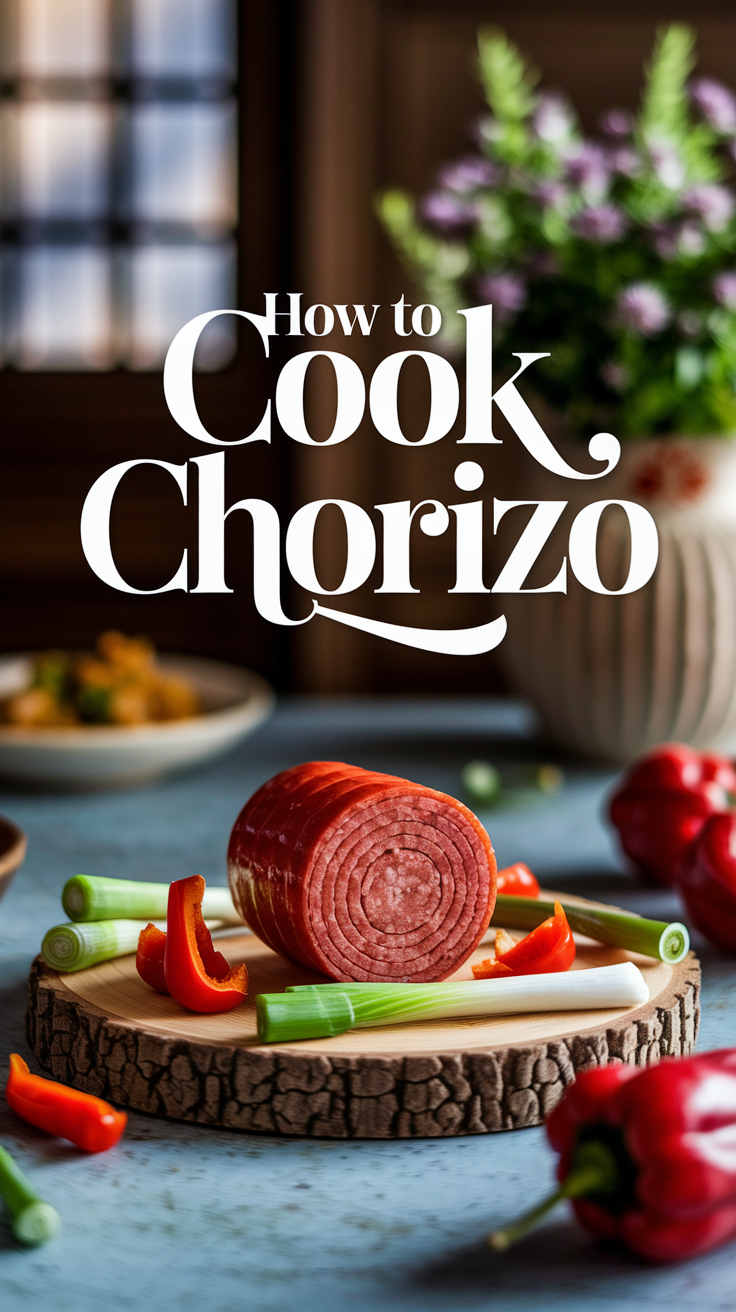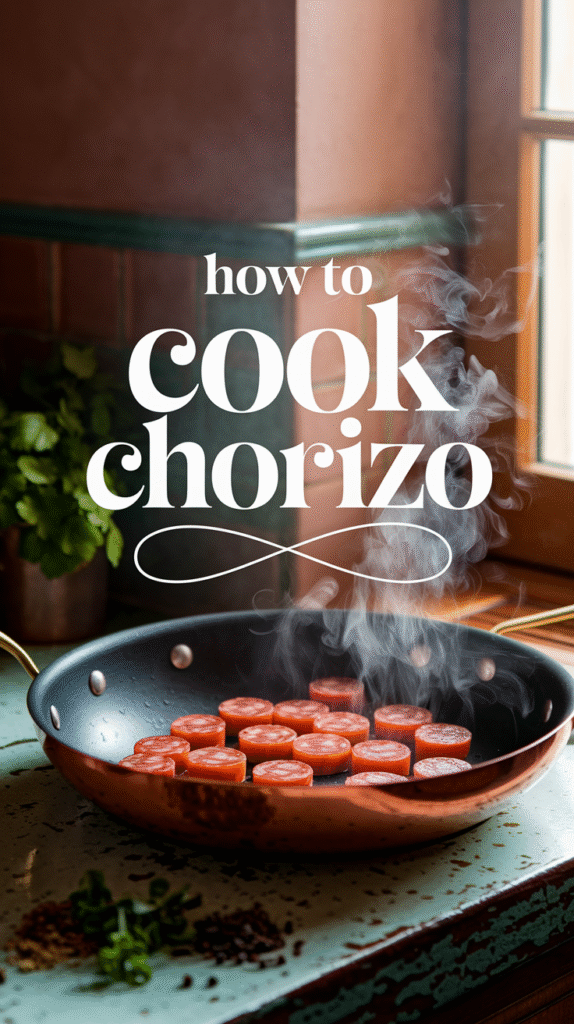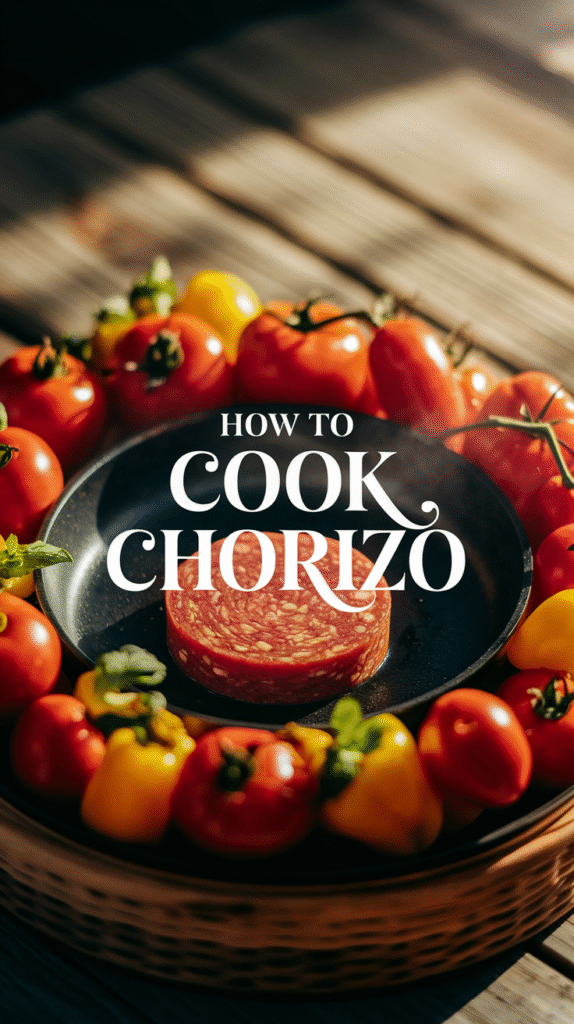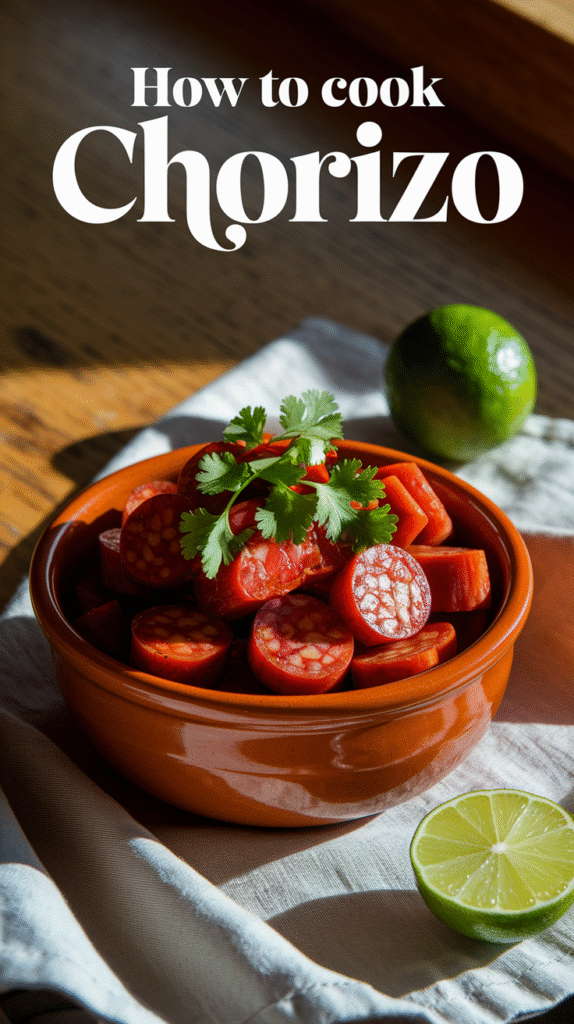Chorizo, a flavorful Spanish and Mexican sausage, adds a vibrant kick to your dishes. Learning how to cook chorizo can elevate your culinary skills and your meals. Follow this step-by-step guide to prepare chorizo perfectly, whether you’re using it in a taco, on a pizza, or in a hearty breakfast scramble.
Choosing Your Chorizo
The first step in cooking chorizo is selecting the right type. You’ll generally find two main varieties:
- Spanish Chorizo: Typically cured and smoked, it’s often sliced and eaten raw or lightly cooked.
- Mexican Chorizo: Fresh and uncooked, it’s seasoned with spices and needs to be cooked before consumption.
For this guide, we will focus on cooking Mexican chorizo since it requires full cooking to develop its flavors.
Gather Your Ingredients
Before you start cooking, make sure you have everything on hand:
- 1 pound of Mexican chorizo
- 1 tablespoon of olive oil (optional, depending on the fat content of your chorizo)
- Your choice of additional ingredients like onions, peppers, or garlic for flavor
- Tortillas (if making tacos)
Cooking Chorizo: Step-by-Step
1. Remove Chorizo from Casing
Begin by taking the chorizo out of its casing. You can simply cut the casing open and squeeze the sausage out into a mixing bowl. Discard the casing.
2. Heat Your Pan
Take a large skillet and add the olive oil. Heat it over medium heat. If your chorizo is high in fat, you may skip the oil to avoid greasiness.
3. Add Chorizo to the Skillet
Once the oil is hot, add the chorizo to the skillet. Break it up with a spatula or wooden spoon to ensure it cooks evenly.
4. Cook Until Browned
Cook the chorizo for about 7 to 10 minutes. Stir it occasionally until it is well browned and crispy on the edges. Ensure that it is fully cooked, reaching an internal temperature of 160°F (71°C).
5. Add Your Extras
If you want to include onions, peppers, or garlic, add them in the last few minutes of cooking. This allows them to soften and meld with the chorizo’s robust flavors.
Serving Suggestions
Now that your chorizo is cooked, you can serve it in various ways:
- Tacos: Serve the chorizo in warm tortillas topped with avocado, salsa, and cilantro.
- Breakfast Scramble: Mix it with scrambled eggs and cheese for a savory breakfast treat.
- Pizza: Use it as a topping combined with mozzarella and bell peppers.
Storing Leftover Chorizo
If you have any leftover cooked chorizo, store it in an airtight container in the refrigerator. Use it within 3 to 4 days. You can also freeze chorizo for longer storage, just make sure to use a freezer-safe container.
Tips for Perfect Chorizo
| Tip | Details |
|---|---|
| Don’t Overcook | Be mindful not to overcook chorizo as it can dry out and lose its juicy texture. |
| Spice It Up | If you like spice, consider adding jalapeños or cayenne pepper when cooking. |
| Pairing | Chorizo goes well with beans, rice, and various vegetables, making it versatile. |
Cooking chorizo is simple and quick, adding a delightful flavor to any dish. Whether you are preparing it for breakfast, lunch, or dinner, you can now confidently cook chorizo to impress your family and friends. Enjoy experimenting with this delicious sausage!
For more recipes and tips on cooking with chorizo, check out resources like Serious Eats or Allrecipes.
The Best Types of Chorizo for Your Recipes
When it comes to delicious, spicy flavors, few ingredients can match the boldness of chorizo. This flavorful sausage can elevate a range of dishes, spanning from breakfast plates to hearty stews. However, to make the most of your culinary creations, it’s essential to choose the right type of chorizo. In this guide, we’ll explore the best types of chorizo available and how to select the perfect one for your recipes.
Types of Chorizo
Chorizo comes in various forms and styles, allowing you to find the perfect match for your culinary needs. Here are some of the most popular types:
- Spanish Chorizo: This type is dry-cured and usually made from pork. It’s seasoned with smoked paprika, garlic, and other spices. Spanish chorizo can be sliced and served as a tapas dish or included in paella.
- Mexican Chorizo: Unlike its Spanish counterpart, Mexican chorizo is fresh and requires cooking before consumption. It’s often made from ground pork and flavored with chili peppers, vinegar, and various seasonings, making it perfect for tacos, burritos, or breakfast dishes.
- Black Chorizo: This type is infused with blood, giving it a unique flavor and color. It is often used in traditional recipes in Spain and can be sliced or added to stews.
- Vegetarian or Vegan Chorizo: For those who prefer plant-based diets, this variant made from soy or other legumes offers a spiced flavor similar to traditional chorizo, making it an excellent alternative in various recipes.
Choosing the Right Chorizo for Your Recipes
When selecting the best chorizo for your dish, consider the following factors:
1. The Dish You Are Making
The type of chorizo you choose often depends on the dish you are preparing. For instance:
| Dish | Recommended Chorizo |
|---|---|
| Tacos | Mexican Chorizo |
| Paella | Spanish Chorizo |
| Breakfast Hash | Mexican Chorizo |
| Tapas | Spanish Chorizo |
2. Spice Level
Chorizo can vary significantly in heat and spice. Spanish chorizo tends to be milder, while Mexican chorizo can pack more heat. Always read labels or inquire about the spice level to match it to your preference.
3. Cooking Method
Choosing a type based on how you plan to cook it is essential. If you’re grilling or sautéing, fresh Mexican chorizo is ideal. If you want to serve it raw, like in a charcuterie board, opt for Spanish chorizo.
Storing Chorizo
Proper storage is vital to keep your chorizo fresh:
- Keep chorizo in the refrigerator if it’s fresh, and consume it within a week. If you have extra, consider freezing it for up to three months.
- Dry chorizo can be kept in a cool, dry place. Once opened, it should be refrigerated and consumed within a few weeks.
Where to Buy Chorizo
You can find a variety of chorizo types at local grocery stores, specialty meat shops, or online retailers. For high-quality options, visit Serious Eats for detailed recipes and product reviews, or check out Food & Wine for culinary insights.
Choosing the right chorizo can transform your meals from ordinary to extraordinary. Whether you prefer the spicy kick of Mexican chorizo or the robust flavor of Spanish chorizo, understanding their unique characteristics will enable you to enhance your cooking. Embrace this flavorful sausage in your next recipe, and enjoy the burst of flavor it brings to your table!
Creative Chorizo Dishes for Any Meal
Chorizo, with its bold flavor and spicy kick, can transform any meal into something spectacular. It’s a versatile ingredient that works well for breakfast, lunch, and dinner. Here are some creative ways to incorporate chorizo into your meals, ensuring a delicious experience at any time of the day.
Breakfast Ideas
Start your day off right with chorizo-infused breakfast options.
- Chorizo Breakfast Burritos: Scramble eggs with diced chorizo and wrap the mixture in a tortilla. Add some avocado, cheese, and salsa for a complete meal.
- Chorizo Hash: Sauté potatoes, onions, and bell peppers with chorizo for a hearty breakfast. Top it with a fried egg for extra protein!
- Chorizo Omelette: A simple omelette filled with sautéed chorizo, onions, and cheese makes for a satisfying breakfast to kickstart your day.
Lunch Delights
Chorizo can also make your midday meals exciting and filling.
- Chorizo Tacos: Use soft or hard taco shells filled with chorizo, lettuce, tomatoes, and a dollop of sour cream for a quick lunch option.
- Spicy Chorizo Salad: Toss chopped greens with cooked chorizo, black beans, corn, and lime dressing for a refreshing yet hearty salad.
- Chorizo Stuffed Peppers: Hollow out bell peppers and fill them with a mixture of chorizo, rice, and cheese. Bake until the peppers are tender.
Dinner Showstoppers
Add some flair to your dinner table with these chorizo recipes.
- Chorizo Pasta: Cook your favorite pasta and mix it with sautéed chorizo and a tomato-based sauce. Finish with fresh basil and Parmesan cheese.
- Chorizo and Chicken Skewers: Marinate chicken pieces in olive oil, garlic, and spices, then layer them with chunks of chorizo. Grill until cooked through for a smoky flavor.
- Chorizo Paella: A Spanish-inspired dish with rice, saffron, and a mix of seafood and spicy chorizo, creating a delightful one-pan meal.
Snacks and Small Plates
Chorizo is perfect for appetizers and snacks too. Consider these options:
- Chorizo and Cheese Board: Serve thin slices of chorizo with an assortment of cheeses, crackers, and olives for a flavorful snack platter.
- Chorizo Crostini: Top toasted baguette slices with a mixture of chorizo, cream cheese, and herbs for a savory bite.
- Chorizo Queso Dip: Melt cheese with cooked chorizo and serve with tortilla chips for a crowd-pleasing dip at your next gathering.
Chorizo in Different Cuisines
Take your taste buds on an adventure by incorporating chorizo into various culinary traditions:
- Mexican: Use chorizo in enchiladas, nachos, or tacos for a spicy kick.
- Spanish: Try it in traditional dishes like fabada asturiana (bean stew) or as an ingredient in your Spanish omelet.
- Italian: Add into pizza or lasagna for depth of flavor and a unique twist.
With its robust flavor, chorizo can elevate ordinary meals into extraordinary ones. You can explore more recipes and ideas by visiting Serious Eats or Food Network. Whether you’re cooking for yourself or hosting a gathering, these chorizo dishes will impress and satisfy your guests.
Now that you have a range of creative options to embrace chorizo, get cooking and enjoy the delightful flavors it brings to your meals!
Tips for Pairing Chorizo with Other Ingredients
Chorizo, a spicy sausage with deep flavors, can elevate any dish. It’s versatile, pairing well with various ingredients. Whether you enjoy the smoky taste of Spanish chorizo or the spiciness of Mexican chorizo, understanding how to combine it with other ingredients can enhance your culinary experiences. Here are some tips that will help you create delicious meals with chorizo.
Combine with Vegetables
Chorizo pairs wonderfully with several vegetables. The spice of the sausage complements the freshness of these ingredients:
- Bell Peppers: Their sweetness balances the heat of chorizo.
- Zucchini: This absorbs the meaty flavor, adding moisture to the dish.
- Potatoes: Fried or roasted, potatoes offer heartiness that mixes well with chorizo.
- Spinach: Perfect for a light, healthy meal; it wilts beautifully when cooked with chorizo.
Elevate with Legumes
Legumes can create a tasty and filling dish when paired with chorizo. Try these combinations:
- Beans: Black beans or pinto beans create a rich protein source, complementing the texture of chorizo.
- Lentils: Their earthy flavor works harmoniously with chorizo, perfect for a hearty stew.
- Chickpeas: The nutty taste of chickpeas adds depth to chorizo dishes like salads or tapas.
Enhance with Grains
Grains provide an excellent base for chorizo, making your meals more satisfying:
- Rice: Chorizo fried rice or paella enhances the flavor of both ingredients.
- Quinoa: This protein-packed grain compliments chorizo in salads or bowls.
- Couscous: The quick-cooking nature of couscous works well for chorizo-based dishes.
Mix with Dairy
The creaminess of dairy softens the spice of chorizo, creating a balanced dish. Consider these pairings:
- Cheese: Feta or queso fresco sprinkle adds saltiness that brightens chorizo flavors.
- Yogurt: A dollop of tangy yogurt can cool down the heat, especially in tacos.
- Cream: cream into sauces with chorizo draws out its robust flavor.
Pairing Tips for Spices and Herbs
Chorizo is already flavorful, so be thoughtful about additional spices and herbs. Here’s what to keep in mind:
- Garlic: Enhances flavor without overpowering the dish.
- Parsley: Adds a fresh touch that lightens the heaviness of chorizo.
- Cilantro: Especially great in Mexican chorizo; it adds a vibrant note.
Perfect with Fruits
Fruit can also be a surprising yet delightful pairing with chorizo:
- Pineapple: The sweetness contrasts beautifully with the sausage’s spice.
- Apples: Sweet apples add a crunchy texture, enhancing a savory dish.
- Peaches: When grilled, peaches bring out a smoky-sweet flavor that complements chorizo.
Creative Combinations for Dishes
If you’re feeling adventurous, these ideas can spark creativity in the kitchen:
| Dish Type | Chorizo Pairing |
|---|---|
| Tacos | Avocado, onion, cilantro |
| Stews | Tomatoes, beans, bell peppers |
| Breakfast Scramble | Eggs, spinach, cheese |
| Pizza | Red onion, mozzarella, jalapeños |
Experimenting with chorizo allows you to find your favorite pairings. Using these tips, you can create enjoyable meals while enhancing the overall taste of your dishes. For more cooking inspiration and recipes, visit Serious Eats or Food Network. Happy cooking!
Common Mistakes to Avoid When Cooking Chorizo
Cooking chorizo can unlock a world of flavor in your dishes, but there are common pitfalls to watch out for. Whether you are a beginner or seasoned cook, avoiding these mistakes can take your chorizo dishes to the next level.
Purchasing the Wrong Type of Chorizo
One of the first mistakes people make is not choosing the right type of chorizo. There are primarily two varieties: Spanish and Mexican. Spanish chorizo is dried and cured, meaning it can be sliced and eaten without cooking. On the other hand, Mexican chorizo is raw and must be cooked before consumption. Ensure you know which type you need for your recipe to avoid food safety issues and flavor mismatches.
Overcooking the Chorizo
Another common mistake is overcooking chorizo. This can lead to a dry, crumbly texture that loses the juicy, flavorful essence. To cook chorizo perfectly:
- Heat the pan: Start with a medium-high heat.
- Add chorizo: Add your chorizo to the pan when it’s hot.
- Cook briefly: Cook until it is browned and cooked through, usually about 5-7 minutes for Mexican chorizo.
Always check the internal temperature when in doubt. Mexican chorizo should reach 160°F (71°C) before it’s safe to eat.
Not Using Enough Oil
Chorizo can be fatty, but adding a bit of oil to your pan can help prevent sticking and ensure even cooking. If you notice the chorizo is sticking to the pan, it’s likely you didn’t use enough oil. A tablespoon or two of olive oil can go a long way, especially when using leaner varieties of chorizo.
Neglecting to Drain Excess Fat
Once you’ve cooked your chorizo, it’s essential to drain excess fat. While the fat provides flavor, too much can overwhelm your dish. After cooking, transfer the chorizo to a paper towel-lined plate to absorb excess grease. This simple step can enhance the overall texture and taste of your meal.
Ignoring Flavor Combinations
Chorizo pairs beautifully with various ingredients. Ignoring complementary flavors can diminish the dish’s potential. Here are some excellent pairings:
- Beans: The heartiness of beans balances the spices in chorizo.
- Eggs: Chorizo and eggs make for a robust breakfast.
- Vegetables: Peppers and onions sautéed with chorizo create a delightful medley.
Experiment with spices, herbs, and vegetables to find your perfect combination!
Not Considering Cooking Methods
Another often overlooked mistake is not considering how you cook your chorizo. Whether you pan-fry, grill, or bake, the cooking method will influence the flavor and texture. For instance:
- Pan-frying: Offers a crispy outside and juicy inside.
- Grilling: Adds a smoky flavor.
- Baking: Though less common, it’s a great way to prepare larger quantities.
Choose your method based on the desired outcome and the recipe you’re following.
Overloading Your Dish
If you include too much chorizo in your dish, it can overpower other flavors. It’s best to use chorizo as a flavor enhancer rather than the main ingredient in more delicate recipes. Aim for a balanced proportion that lets all components shine.
Not Slicing or Crumbling Properly
For certain dishes, how you prepare chorizo makes a difference. If the recipe requires smaller pieces, don’t hesitate to crumble or slice it finely. This ensures an even distribution of flavor throughout the dish. For example, when adding to tacos, crumbled chorizo will mix beautifully with other toppings.
To elevate your cooking experience further, consider checking out resources such as Serious Eats or Food Network for additional tips and recipes specific to chorizo.
With these tips in mind, you’ll be well on your way to mastering the art of cooking chorizo. Avoid these common mistakes, and your dishes are sure to impress!
Conclusion
Cooking chorizo opens up a world of flavor that can enhance a variety of meals. By following the step-by-step guide provided, you’ll master the essential techniques to cook this spicy sausage perfectly every time. Understanding the different types of chorizo—whether Spanish or Mexican—will allow you to choose the best option for your dish, ensuring a delightful culinary experience that aligns with your taste preferences.
Additionally, exploring creative chorizo dishes means you can expand your menu and delight your family or guests with exciting flavors. From breakfast burritos to gourmet pizzas, the versatility of chorizo lets you experiment freely in the kitchen. Pairing chorizo with complementary ingredients, such as fresh vegetables, cheeses, or even zesty sauces, will further elevate your recipes. Just remember to consider balance and flavor profiles for the best results.
While cooking chorizo is straightforward, avoiding common mistakes is crucial. Overcooking or under-seasoning can detract from the deliciousness of this dish. By being mindful of your cooking methods and taste adjustments, you can prevent these pitfalls and create a satisfying meal.
With these insights and tips in hand, you’re now equipped to take your chorizo cooking skills to the next level. Embrace your creativity in the kitchen and enjoy the bold flavors that chorizo brings to your culinary repertoire. Happy cooking!







Leave a Reply